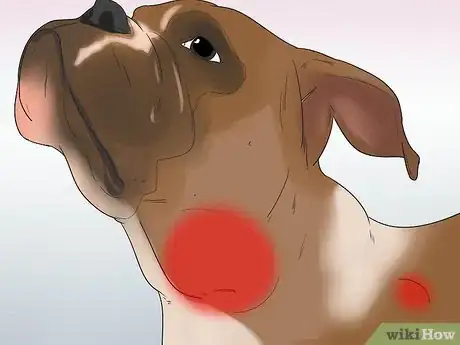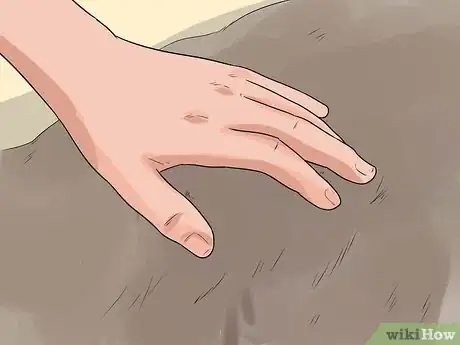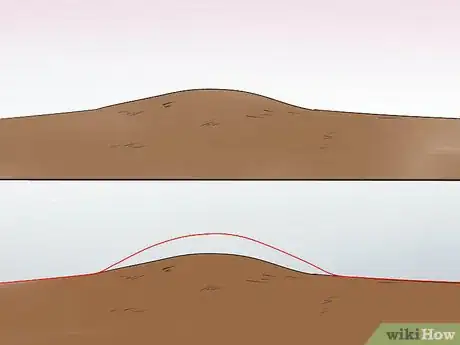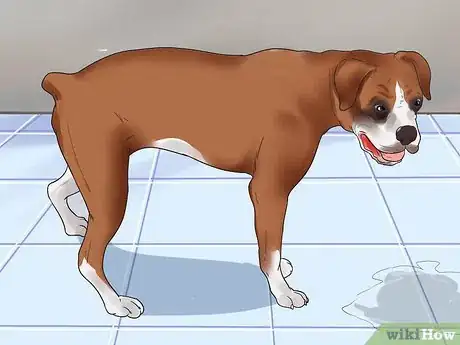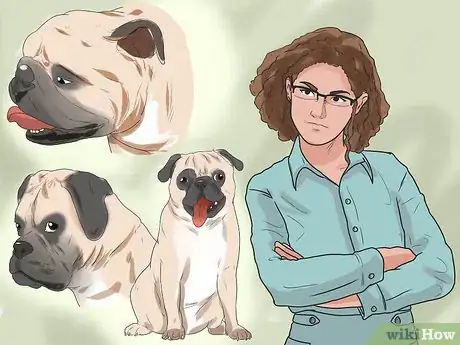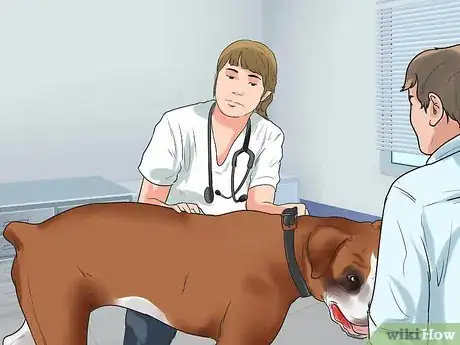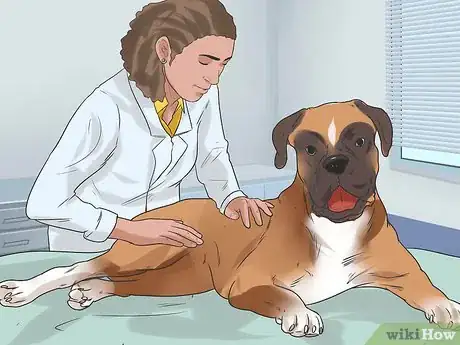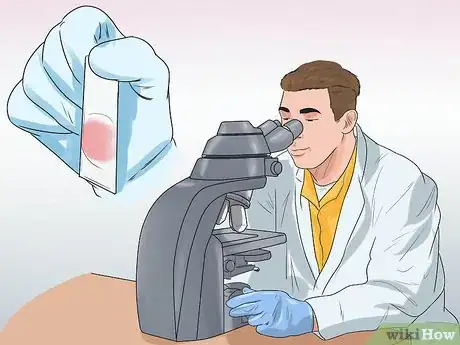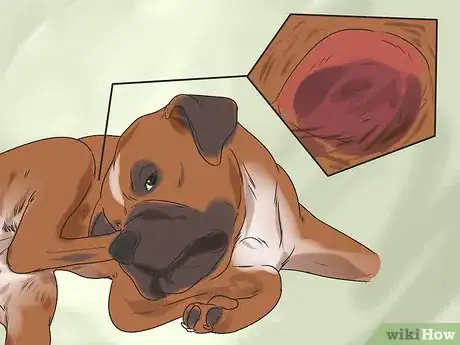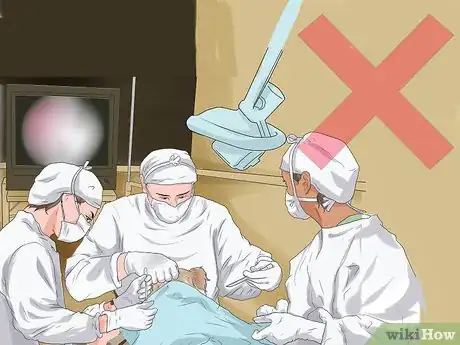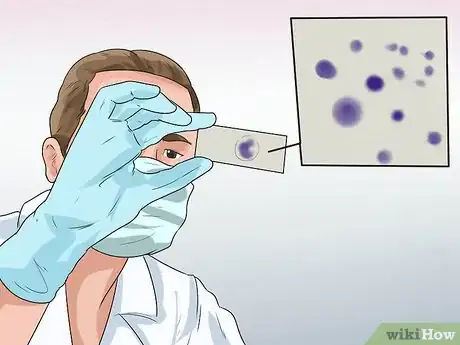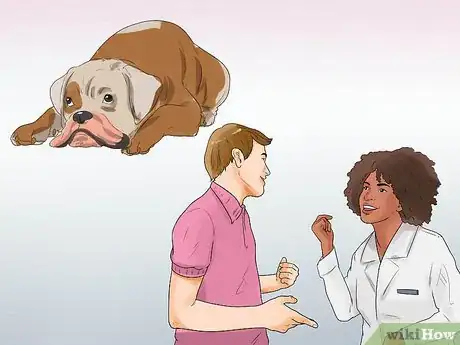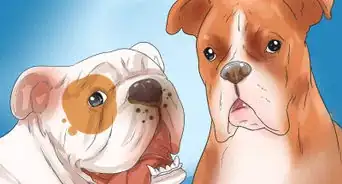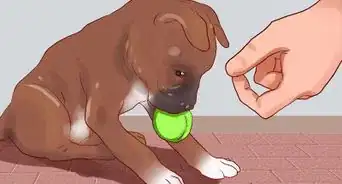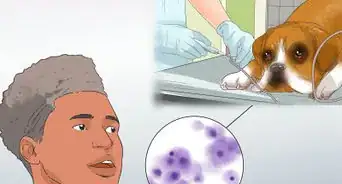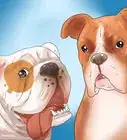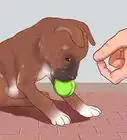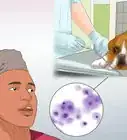This article was co-authored by Pippa Elliott, MRCVS and by wikiHow staff writer, Jessica Gibson. Dr. Elliott, BVMS, MRCVS is a veterinarian with over 30 years of experience in veterinary surgery and companion animal practice. She graduated from the University of Glasgow in 1987 with a degree in veterinary medicine and surgery. She has worked at the same animal clinic in her hometown for over 20 years.
This article has been viewed 26,331 times.
All dogs have mast cells. These are white blood cells that deal with inflammation and allergic reactions. Unfortunately, mast cells can form tumors when abnormal numbers group together in the skin. Mast cell tumors (MCT) are one of the most commonly occurring cancers of the skin to affect dogs. Since MCT are hard to recognize and diagnose by sight, it's important to get immediate medical attention if you notice your dog has a lump.[1] [2]
Steps
Recognizing Symptoms
-
1Look for lumps on the skin. Pay attention to any new lump you find on your dog. Mast cell tumors (MCT) are notoriously difficult to describe because they show up in a variety of ways. MCT might be smooth or bumpy. The lump may be large or small. There may just be one lump or several all together.[3]
- At their most innocent, MCT can be pea-sized skin lumps on the surface of the skin.
-
2Check your Boxer for lumps under the skin. MCT can also form round lumps beneath the skin. Just like superficial lumps, these external MCT can range in texture and feel. These MCT can sometimes be mistaken for harmless fatty lumps. Unfortunately, they're incredibly dangerous for your dog.
- Most MCT form along the dog's trunk and limbs.[4]
Advertisement -
3Monitor changes to the lump. MCT can change in size so it's important to pay attention to the size of the lump or any changes in its appearance. Sometimes the MCT might look harmless and then they seem sore and inflamed. Or, you may notice your dog only has one lump, but there are more a few weeks later.[5]
- MCT may change so gradually that it's hard to notice, especially if it develops over several months. Or, the MCT might change rapidly, within several days.
-
4Watch for reactions to histamines. In general, MCT won't cause your dog pain or irritation, unless they're scratched. Mast cells contain natural chemicals, like histamines, heparin, and proteins which break down tissue. If there are several MCT in an area and the MCT are scratched or traumatized, these chemicals can suddenly release. These chemicals can have a dangerous effect on your dog and can even send him into shock. Signs of a reaction to MCT chemicals include:[6] [7]
- Swelling of the lumps
- Itchy lumps
- Vomiting
- Ulcers
- Blood in the stool
- Abnormalities in blood clotting
-
5Recognize your dog's risk. Although any dog can develop MCT, certain breeds are genetically prone to develop them. These include the Golden Retriever, Boston Terrier, Staffordshire Bull Terrier, pugs, bulldogs, and the Boxer. Of these, the Boxer is at the highest risk.[8]
- MCT can occur in dogs of any age and they are frequently found in young and middle-aged dogs.
-
6Get medical attention. If you notice any lump or believe your Boxer is reacting to chemicals from a MCT, get him checked by a veterinarian as soon as possible. Just looking at the lump isn't enough to determine what kind of a lump it is or what caused it.[9]
- High-risk breeds should always have any new skin lump examined, no matter how harmless it looks.
Getting a Medical Diagnosis
-
1Get a physical examination. The vet will check your dog and feel his lymph nodes. This is to check whether or not the lymph nodes are swollen or enlarged, which can be a sign of an aggressive MCT. The vet will carefully check for other skin lumps.
- Your vet will feel your Boxer's abdomen to see whether or not the lumps have spread internally.
-
2Test the tumor's cells. The vet will place a fine needle into the lump and pull the syringe back. This aspirates (sucks back) a sample of cells into the needle. The vet can then spray the cells onto a microscope slide and a cytologist can examine them under a microscope.[10]
- The cytologist looks for the typical granular appearance of mast cells.[11]
-
3Reassess the lump. If the sample doesn't show mast cells and the vet is certain that the sample was good, your Boxer might not have MCT. The vet will probably want to monitor the lump closely. If it gets larger or you notice your dog scratching it, you'll need to have your dog reassessed.
- A negative sample doesn't guarantee that the lump isn't a mass cell tumor. Sample sizes are usually so small that correct testing depends on mass cells being sucked up into the syringe.
Treating Mast Cell Tumors
-
1Get surgery to remove the tumors. If the cell sample shows that your dog has MCT, this confirms the diagnosis. Your dog will need to have the lumps surgically removed. After the surgery, your veterinarian will discuss further treatment options with you since your dog may need additional surgery or radiation.[12]
- Once removed, the whole lump will be sent to a histologist for analysis. This will confirm whether the lump was a MCT or not.
-
2Check for secondary tumors. Since some forms of MCT are more aggressive than others, your dog will be screened for secondary tumors. The vet will also use the analysis from the lump that was already removed to determine if your dog has an aggressive tumor.
- Aggressive secondary tumors can also be found using special stains that show up in malignant cells.[13]
-
3Follow the veterinarian's treatment plan. If your Boxer has aggressive MCT that are spreading, the vet may put him on medication while he gets treatment. Medications might include steroids to kill cancerous cells or antihistamines to reduce inflammation caused by the tumor.[14]
- Side effects of steroids include increased thirst, increased appetite, nausea or vomiting, and panting. Your dog may need antacids to reduce some of these side effects.
Expert Q&A
-
QuestionAre tumors common in Boxers?
 Pippa Elliott, MRCVSDr. Elliott, BVMS, MRCVS is a veterinarian with over 30 years of experience in veterinary surgery and companion animal practice. She graduated from the University of Glasgow in 1987 with a degree in veterinary medicine and surgery. She has worked at the same animal clinic in her hometown for over 20 years.
Pippa Elliott, MRCVSDr. Elliott, BVMS, MRCVS is a veterinarian with over 30 years of experience in veterinary surgery and companion animal practice. She graduated from the University of Glasgow in 1987 with a degree in veterinary medicine and surgery. She has worked at the same animal clinic in her hometown for over 20 years.
Veterinarian Sadly, Boxers, along with several other short-haired breeds, are over-represented when it comes to mast cell tumors. Indeed, these tumors are common enough to mean that an owner should get any lump on a Boxer dog checked out by a vet.
Sadly, Boxers, along with several other short-haired breeds, are over-represented when it comes to mast cell tumors. Indeed, these tumors are common enough to mean that an owner should get any lump on a Boxer dog checked out by a vet. -
QuestionAre mast cell tumors painful for a dog?
 Pippa Elliott, MRCVSDr. Elliott, BVMS, MRCVS is a veterinarian with over 30 years of experience in veterinary surgery and companion animal practice. She graduated from the University of Glasgow in 1987 with a degree in veterinary medicine and surgery. She has worked at the same animal clinic in her hometown for over 20 years.
Pippa Elliott, MRCVSDr. Elliott, BVMS, MRCVS is a veterinarian with over 30 years of experience in veterinary surgery and companion animal practice. She graduated from the University of Glasgow in 1987 with a degree in veterinary medicine and surgery. She has worked at the same animal clinic in her hometown for over 20 years.
Veterinarian Mast cells tumors contain histamine, which makes the lumps itchy. This is why dogs may rub, bite, or scratch at mast cell tumors, because the lumps degranulate and cause intense itching.
Mast cells tumors contain histamine, which makes the lumps itchy. This is why dogs may rub, bite, or scratch at mast cell tumors, because the lumps degranulate and cause intense itching. -
QuestionCan dogs survive mast cell tumors?
 Pippa Elliott, MRCVSDr. Elliott, BVMS, MRCVS is a veterinarian with over 30 years of experience in veterinary surgery and companion animal practice. She graduated from the University of Glasgow in 1987 with a degree in veterinary medicine and surgery. She has worked at the same animal clinic in her hometown for over 20 years.
Pippa Elliott, MRCVSDr. Elliott, BVMS, MRCVS is a veterinarian with over 30 years of experience in veterinary surgery and companion animal practice. She graduated from the University of Glasgow in 1987 with a degree in veterinary medicine and surgery. She has worked at the same animal clinic in her hometown for over 20 years.
Veterinarian Mast cell tumors are complex, and can range from Grade 1 (curable with surgery) through to Grade 3 (potential to come back or spread). In many cases, surgical removal of the lump is curative, so in this respect, yes, dogs can survive. There are also some highly effective medications which shrink mast cells tumors down and aid survival.
Mast cell tumors are complex, and can range from Grade 1 (curable with surgery) through to Grade 3 (potential to come back or spread). In many cases, surgical removal of the lump is curative, so in this respect, yes, dogs can survive. There are also some highly effective medications which shrink mast cells tumors down and aid survival.
References
- ↑ http://www.peteducation.com/article.cfm?c=2+2087&aid=461
- ↑ http://www.wearethecure.org/mast-cell-tumors
- ↑ http://www.peteducation.com/article.cfm?c=2+2087&aid=461
- ↑ http://www.wearethecure.org/mast-cell-tumors
- ↑ http://www.vet.upenn.edu/docs/default-source/ryan/oncology-handouts/final-canine-mct.pdf?sfvrsn=4
- ↑ http://www.peteducation.com/article.cfm?c=2+2087&aid=461
- ↑ http://www.wearethecure.org/mast-cell-tumors
- ↑ http://www.wearethecure.org/mast-cell-tumors
- ↑ http://www.vet.upenn.edu/docs/default-source/ryan/oncology-handouts/final-canine-mct.pdf?sfvrsn=4
- ↑ http://www.peteducation.com/article.cfm?c=2+2087&aid=461
- ↑ http://www.vet.upenn.edu/docs/default-source/ryan/oncology-handouts/final-canine-mct.pdf?sfvrsn=4
- ↑ http://www.vet.upenn.edu/docs/default-source/ryan/oncology-handouts/final-canine-mct.pdf?sfvrsn=4
- ↑ http://www.wearethecure.org/mast-cell-tumors
- ↑ http://www.vet.upenn.edu/docs/default-source/ryan/oncology-handouts/final-canine-mct.pdf?sfvrsn=4
About This Article
To diagnose mast cell tumors in boxers, look and feel for lumps on and under your dog's skin. If you find lumps, monitor them for changes since mast cell tumors change in size and can spread. Also, keep an eye out for other symptoms, like swelling, itching, vomiting, ulcers, and bloody stool. These symptoms could be a sign that your dog is having a reaction to the chemicals in its tumors. If you think your boxer has mast cell tumors, take it to a vet to get a proper diagnosis. For more advice from our Veterinary co-author, like how to treat mast cell tumors in a boxer, scroll down.
